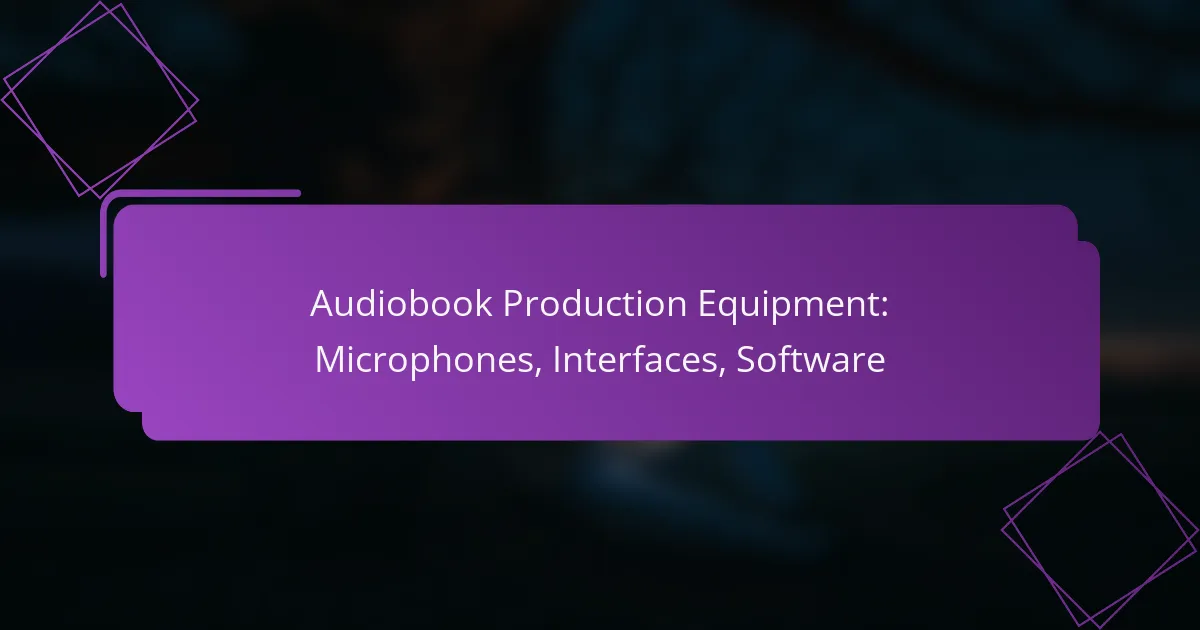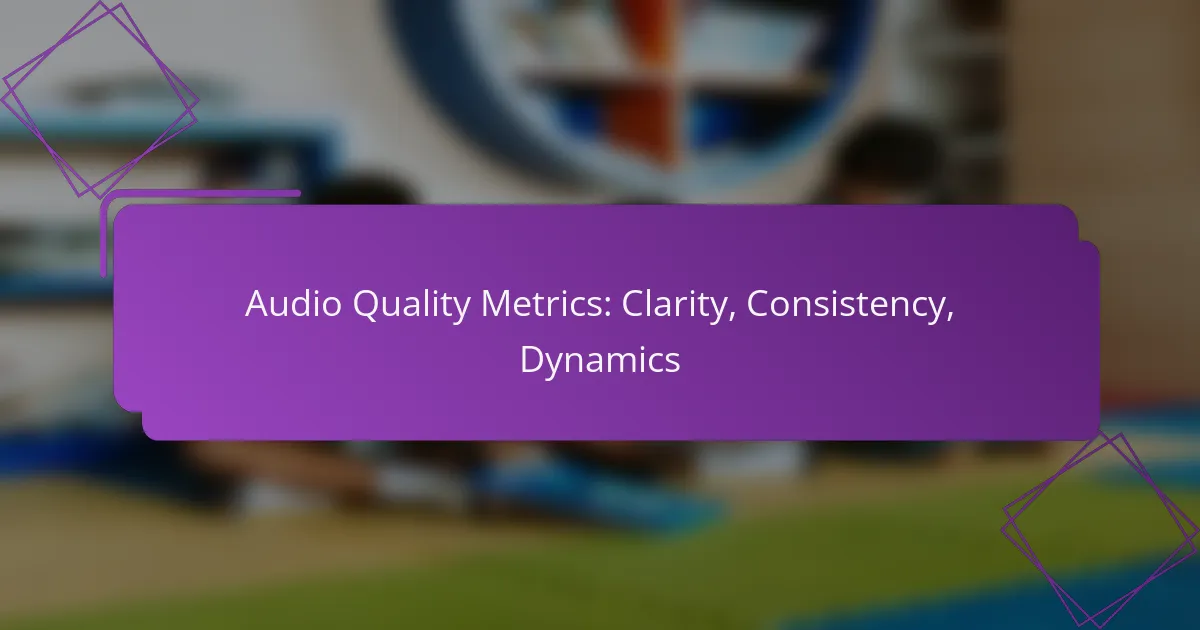Creating high-quality audiobooks requires the right equipment, including microphones, audio interfaces, and software. Selecting a microphone that captures clear sound while reducing background noise is essential, with dynamic and condenser options available for various environments. Additionally, a reliable audio interface enhances sound quality and ensures seamless integration with your recording software, while programs like Adobe Audition and Audacity provide the necessary tools for effective editing and production.
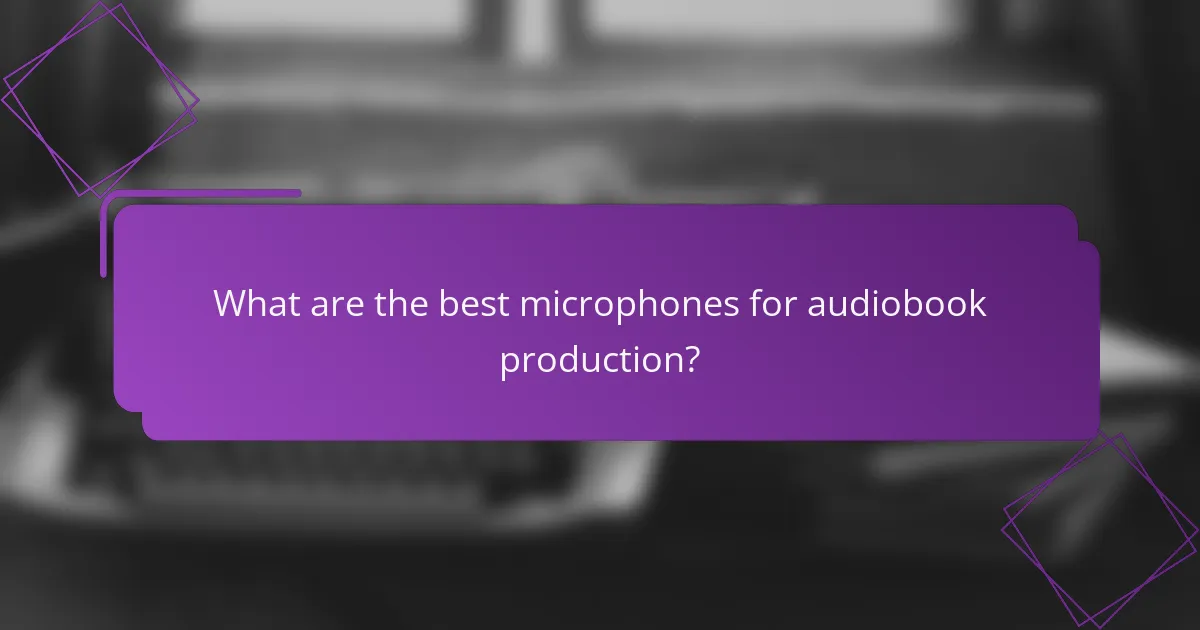
What are the best microphones for audiobook production?
The best microphones for audiobook production are those that capture clear, natural sound while minimizing background noise. Popular choices include dynamic and condenser microphones, each offering unique benefits suited for different recording environments.
Shure SM7B
The Shure SM7B is a dynamic microphone known for its versatility and rich sound quality. It excels in vocal recording, making it a favorite among audiobook narrators. Its built-in air suspension system reduces unwanted noise, which is crucial for achieving a clean recording.
When using the SM7B, consider pairing it with a quality preamp, as it requires a good amount of gain. This microphone is particularly effective in untreated rooms, as its design helps to minimize ambient noise.
Audio-Technica AT2020
The Audio-Technica AT2020 is a popular condenser microphone that offers excellent sound clarity at an affordable price. It features a cardioid polar pattern, which helps isolate the voice from background sounds, making it suitable for home studios.
This microphone is ideal for narrators who want a balance between quality and cost. It performs well in various recording settings, but be mindful of its sensitivity to plosives; using a pop filter can enhance the recording quality.
Rode NT1
The Rode NT1 is renowned for its ultra-low self-noise, making it one of the quietest studio microphones available. This condenser mic captures detailed vocal nuances, which is essential for engaging audiobook narration.
Its wide frequency response allows for a natural sound reproduction, but it may require careful placement to avoid picking up unwanted room noise. The NT1 is a great choice for those seeking professional-grade audio without breaking the bank.
Neumann TLM 102
The Neumann TLM 102 is a premium condenser microphone that delivers exceptional sound quality. Its compact design and large diaphragm make it perfect for capturing the subtleties of the human voice, which is vital for audiobooks.
This microphone is slightly more expensive but is often considered an investment due to its durability and performance. It works well in both professional studios and home setups, providing a polished sound that enhances narration.
AKG C214
The AKG C214 is a versatile condenser microphone that offers a warm sound profile, ideal for voice recording. It features a switchable low-cut filter and a -20 dB pad, allowing for flexibility in various recording situations.
This microphone is particularly effective for narrators who want to capture a rich vocal tone without excessive background noise. Its robust build quality makes it suitable for both studio and mobile recording setups.

Which audio interfaces are ideal for recording audiobooks?
When recording audiobooks, the ideal audio interfaces should provide high-quality sound, low latency, and user-friendly features. Look for interfaces that offer multiple inputs, good preamps, and compatibility with your recording software.
Focusrite Scarlett 2i2
The Focusrite Scarlett 2i2 is a popular choice for audiobook recording due to its excellent sound quality and ease of use. It features two high-performance mic preamps, allowing you to connect two microphones simultaneously, which is useful for voiceover work.
With a USB-C connection, it offers low latency and is compatible with most recording software. Its compact design makes it portable, ideal for recording on the go.
PreSonus AudioBox USB 96
The PreSonus AudioBox USB 96 is another solid option for audiobook production. It provides two combo inputs for microphones or instruments and comes with a software bundle that includes Studio One Artist, enhancing your recording capabilities.
This interface is known for its durability and straightforward setup, making it suitable for beginners and experienced users alike. Its 24-bit/96 kHz resolution ensures clear audio quality for voice recordings.
Universal Audio Apollo Solo
The Universal Audio Apollo Solo is a high-end audio interface that excels in sound quality and processing power. It features Unison technology, which allows you to emulate classic preamps, providing a professional touch to your recordings.
While it comes at a higher price point, its superior audio fidelity and built-in effects make it a worthwhile investment for serious audiobook narrators. It connects via Thunderbolt, ensuring fast data transfer and low latency.
Behringer UMC22
The Behringer UMC22 is an affordable audio interface that doesn’t compromise on quality. It features a single combo input and a built-in MIDAS preamp, which is known for its clarity and warmth, making it suitable for voice recordings.
This interface is ideal for those on a budget, offering good performance for its price. However, it has limited inputs, so it’s best for solo recording sessions.
Zoom U-24
The Zoom U-24 is a versatile audio interface that can function as both a portable recorder and an interface for your computer. It features two inputs and allows for battery operation, making it great for recording audiobooks in various locations.
Its built-in effects and easy-to-use interface make it a practical choice for narrators who need flexibility. The U-24 also supports high-resolution audio recording, ensuring your voice is captured with clarity.
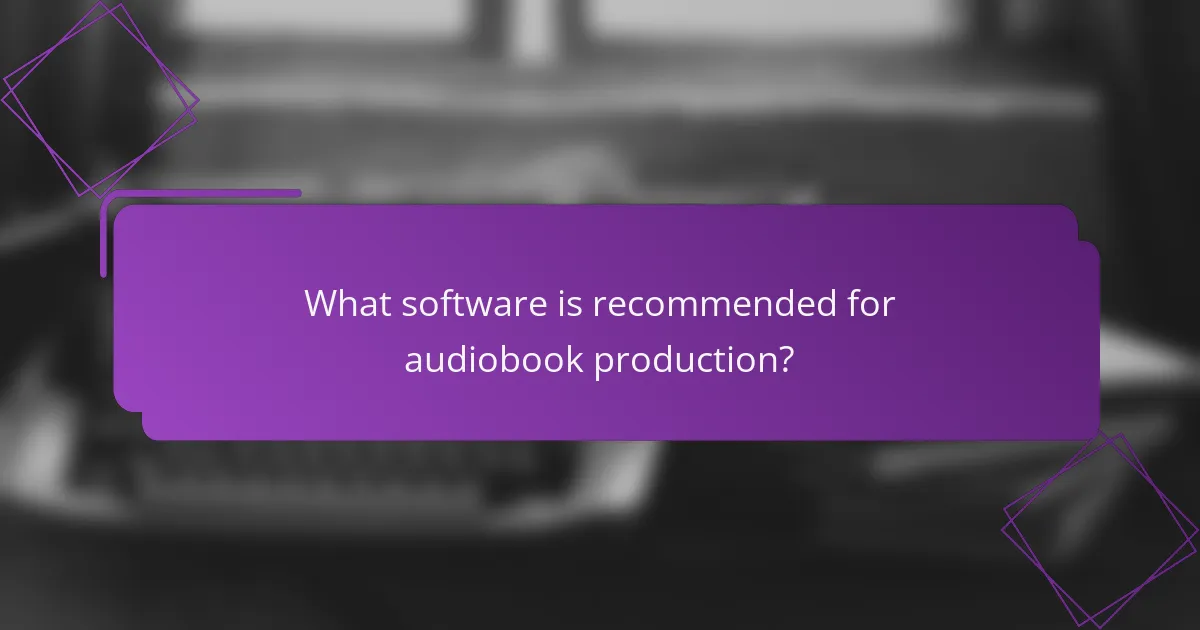
What software is recommended for audiobook production?
For audiobook production, recommended software includes Adobe Audition, Audacity, Reaper, Pro Tools, and GarageBand. Each of these programs offers unique features suited for recording, editing, and producing high-quality audio content.
Adobe Audition
Adobe Audition is a professional-grade audio editing software known for its comprehensive features. It supports multi-track editing, allowing users to mix different audio sources seamlessly. The intuitive interface and powerful tools make it ideal for detailed audio manipulation and restoration.
Consider using Adobe Audition if you require advanced features like noise reduction, audio effects, and extensive format support. However, it comes with a subscription cost, which may be a factor for budget-conscious users.
Audacity
Audacity is a free, open-source audio editing software that is popular among beginners and professionals alike. It offers essential features for recording and editing audio, including multi-track capabilities and a variety of effects. Its user-friendly interface makes it easy to navigate for those new to audiobook production.
While Audacity lacks some advanced features found in paid software, it is a great starting point for those on a budget. Be mindful of its limitations in handling larger projects, as performance may vary with extensive audio files.
Reaper
Reaper is a cost-effective digital audio workstation (DAW) that provides a flexible and customizable environment for audiobook production. It supports a wide range of audio formats and offers powerful editing tools, making it suitable for both recording and post-production work.
Reaper’s pricing model is appealing, as it offers a free trial and a low-cost license for personal use. However, the learning curve can be steeper compared to simpler software, so users may need to invest time in mastering its features.
Pro Tools
Pro Tools is an industry-standard software widely used in professional audio production, including audiobooks. It offers advanced editing, mixing, and mastering capabilities, making it suitable for high-quality audio projects. Pro Tools is particularly favored for its robust plugin support and collaboration features.
While Pro Tools is powerful, it comes with a higher price tag and may require a more powerful computer to run efficiently. It is best suited for users who are serious about audio production and willing to invest in their setup.
GarageBand
GarageBand is a user-friendly audio production software available for macOS and iOS users. It is ideal for beginners, offering a simple interface and essential tools for recording and editing audiobooks. GarageBand includes built-in loops and effects, which can enhance the audio experience.
Although GarageBand lacks some advanced features of professional software, it is a great option for those just starting out. Users should consider transitioning to more advanced software as their production needs grow.

How to choose the right microphone for audiobooks?
Choosing the right microphone for audiobooks is crucial for achieving high-quality sound. Look for a microphone that captures clear audio while minimizing background noise, as this will enhance the listening experience.
Consider pickup pattern
The pickup pattern of a microphone determines how it captures sound from different directions. For audiobooks, a cardioid pattern is often preferred because it picks up sound primarily from the front, reducing ambient noise from the sides and rear.
Other patterns, like omnidirectional, capture sound from all directions, which may not be ideal in untreated rooms. If you’re in a noisy environment, stick with cardioid or supercardioid microphones to ensure clarity.
Evaluate frequency response
Frequency response refers to the range of frequencies a microphone can capture effectively. For voice recordings, look for microphones that excel in the mid-range frequencies, typically between 80 Hz and 15 kHz, as this range is where most vocal sounds reside.
Some microphones may emphasize certain frequencies, which can color the sound. A flat frequency response is often best for audiobooks, as it provides a more natural representation of the voice.
Assess budget
Your budget will significantly influence your microphone choice. Entry-level microphones suitable for audiobooks can start around $100, while professional-grade options can range from $300 to over $1,000.
Consider not only the microphone but also any necessary accessories, like pop filters and shock mounts, which can add to the overall cost. Investing in a quality microphone can pay off in the long run with better audio quality and reduced editing time.
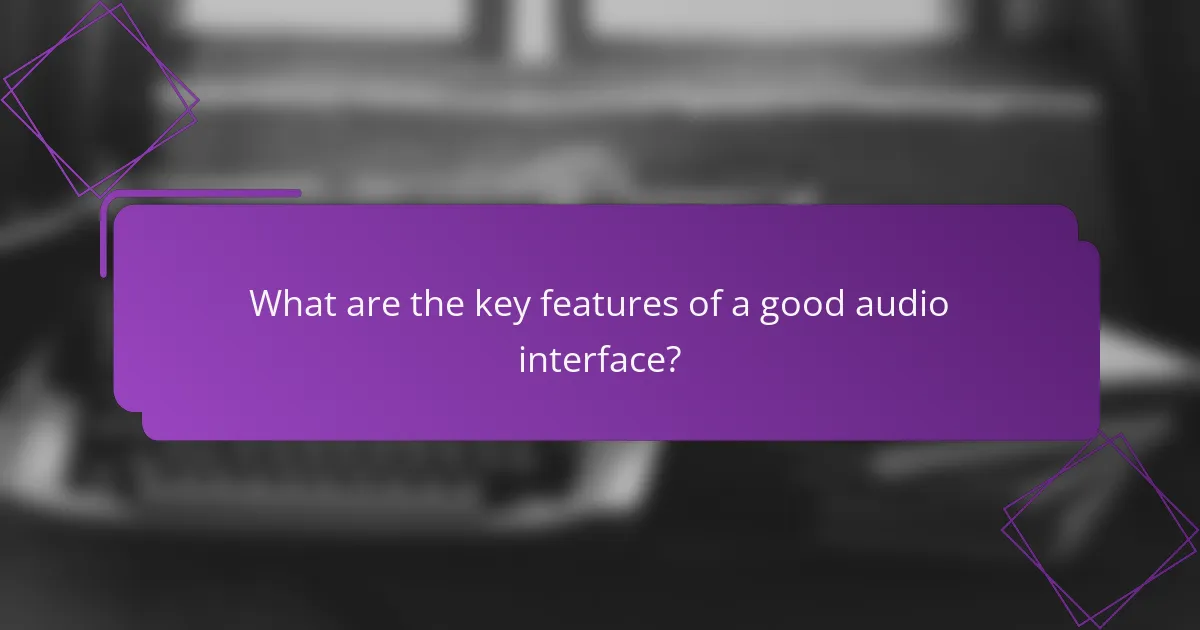
What are the key features of a good audio interface?
A good audio interface should provide high-quality sound conversion, low latency, and compatibility with various recording software. These features ensure that audio recordings are clear and that the interface integrates seamlessly into your production setup.
Low latency performance
Low latency performance is crucial for real-time audio monitoring and recording. Ideally, latency should be kept below 10 milliseconds to ensure that what you hear aligns closely with what is being recorded, preventing delays that can disrupt the recording process.
To achieve low latency, consider interfaces that use USB 3.0 or Thunderbolt connections, as these tend to offer faster data transfer rates. Additionally, look for interfaces that support direct monitoring, allowing you to hear your input signal without the delay introduced by the computer’s processing.
When selecting an audio interface, check user reviews and specifications for latency performance. Many manufacturers provide latency benchmarks, which can help you compare options effectively and choose an interface that meets your recording needs.
